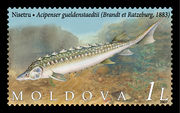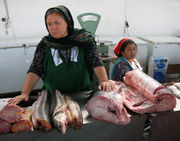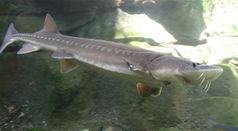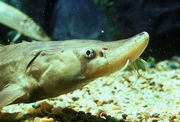Sturgeon
| Sturgeon Fossil range: Upper Cretaceous–Recent [1] |
|
|---|---|
 |
|
| Atlantic sturgeon (Acipenser oxyrinchus oxyrinchus) |
|
| Scientific classification | |
| Kingdom: | Animalia |
| Phylum: | Chordata |
| Class: | Actinopterygii |
| Order: | Acipenseriformes |
| Family: | Acipenseridae |
| Subfamilies | |
|
Acipenserinae |
|
Sturgeon is the common name used for some 26 species of fish in the family Acipenseridae, including the genera Acipenser, Huso, Scaphirhynchus and Pseudoscaphirhynchus. The term includes over 20 species commonly referred to as sturgeon and several closely related species that have distinct common names, notably sterlet, kaluga and beluga. Collectively, the family is also known as the True Sturgeons. Sturgeon is sometimes used more exclusively to refer to the species in the two best-known genera; Acipenser and Huso.
One of the oldest families of bony fish in existence, sturgeon are native to subtropical, temperate and sub-Arctic rivers, lakes and coastlines of Eurasia and North America. They are distinctive for their elongated bodies, lack of scales, and occasional great size: Sturgeons ranging from 7–12 feet (2-3½ m) in length are common, and some species grow up to 18 feet (5.5 m). Most sturgeons are anadromous bottom-feeders, spawning upstream and feeding in river deltas and estuaries. While some are entirely freshwater, very few venture into the open ocean beyond near coastal areas.
Several species of sturgeons are harvested for their roe, which is made into caviar—a luxury good which makes some sturgeons pound for pound the most valuable of all harvested fish. Because they are slow-growing and mature very late in life, they are particularly vulnerable to exploitation and to other threats, including pollution and habitat fragmentation. Most species of sturgeons are currently considered vulnerable, endangered or critically endangered.
Contents |
Evolution
Sturgeon and related paddlefish appeared in the fossil record approximately 200 million years ago, making them among the most ancient of actinopterygian fishes. In that time they have undergone remarkably little morphological change, indicating that their evolution has been exceptionally slow and earning them informal status as living fossils.[2][3] This is explained in part by the long inter-generation time, tolerance for wide ranges of temperature and salinity, lack of predators due to size, and the abundance of prey items in the benthic environment.
Despite the existence of a fossil record, it has been difficult to fully classify the sturgeon species or unambiguously determine their phylogeny. This is in part due to the high individual and ontogenic variation, including geographical clines in certain features, such as rostrum shape, number of scutes and body length. A further confounding factor is the peculiar ability of sturgeons to produce reproductively viable hybrids, even between species assigned to different genera. The wide range of the Acipenserids and their endangered status have made collection of systematic materials difficult. These factors have led researchers in the past to identify over 40 additional species that were rejected by later workers.[4] It is still unclear whether the species in the Acipenser and Huso genera are monophyletic (descended from one ancestor) or paraphyletic (descended from many ancestors)—though it is clear that the morphologically motivated division between these two genera is not supported by the genetic evidence. There is an ongoing effort to resolve the taxonomic confusion using a continuing synthesis of systematic data and molecular techniques.[3][5]
Physical characteristics

Along with other members of the Chondrostei and the Acipenseriformes order, sturgeon are primarily cartilaginous, lack a vertebral centrum, and are covered with bony plates called scutes rather than scales. They also have four barbels—tactile organs that precede their toothless mouth and are dragged along often murky river bottoms. Sturgeon are distinctly and immediately recognizable for their elongated bodies, flattened rostra, distinctive scutes and barbels, and elongated upper tail lobes.
They are primarily benthic feeders. With their projecting wedgeshaped snout they stir up the soft bottom, and use the barbels to detect shells, crustaceans and small fish, on which they feed. Having no teeth, they are unable to seize prey, though larger specimens can swallow very large prey items, including whole salmon.[6]
Sturgeon have been referred to as both the Leviathans and Methuselahs of freshwater fish. They are among the largest fish: some beluga (Huso huso) in the Caspian Sea reportedly attain over 5.5 m (18 ft.) and 2000 kg[7] (4400 lbs.) while for kaluga (H. dauricus) in the Amur River similar lengths and over 1000 kg (2200 lbs.) weights have been reported.[8] White sturgeon of similar size have long been reported from the Columbia River and its tributary the Snake River, both of which can be at least 100 feet (30 meters) deep in reservoirs behind dams. They are also probably the longest-lived of the fishes, some living well over 100 years and attaining sexual maturity at 20 years or more.[9] The combination of slow growth and reproductive rates and the extremely high value placed on mature egg-bearing females make sturgeon particularly vulnerable to overfishing.
Sturgeons are polyploid; some species have 4, 8, or 16 sets of chromosomes.[10]
Range and habitat
Sturgeon range from subtropical to subarctic waters in North America and Eurasia. In North America, they range along the Atlantic coast from the Gulf of Mexico to Newfoundland, including the Great Lakes and the St. Lawrence, Missouri and Mississippi rivers, as well as along the West coast in major rivers from California to British Columbia. They occur along the European Atlantic coast, including the Mediterranean basin, in the rivers that flow into the Black, Azov and Caspian seas (Danube, Dnepr, Volga and Don), the north-flowing rivers of Russia that feed the Arctic Ocean (Ob, Yenisei, Lena, Kolyma), in the rivers of Central Asia (Amu Darya and Syr Darya) and Lake Baikal. In the Pacific Ocean, they are found in the Amur River along the Russian-Chinese border, on Sakhalin island, and in the Yangtze and other rivers in northeast China.[9][11]
Throughout this extensive range, almost all species are highly threatened or vulnerable to extinction due to a combination of habitat destruction, overfishing and pollution.[11]
No species are known to naturally occur south of the equator, though attempts at sturgeon aquaculture are being made in Uruguay, South Africa and other places.[12]
Most species are at least partially anadromous, spawning in fresh water and feeding in nutrient rich brackish waters of estuaries or undergoing significant migrations along coastlines. However, some species have evolved purely freshwater existences, such as the lake sturgeon (Acipenser fulvescens) and the Baikal sturgeon (A. baerii baicalensis), or have been forced into them by anthropogenic or natural impoundment of their native rivers, as in the case of some subpopulations of white sturgeon (A. transmontanus) in the Columbia River[13] and Siberian sturgeon (A. baerii) in the Ob basin.[14]
Uses

In Russia, sturgeon fisheries are of immense value. Early in summer the fish migrate into the rivers or towards the shores of freshwater lakes in large shoals for breeding purposes. The ova are very small, and so numerous that one female has been calculated to produce about three million in one season. The ova of some species have been observed to hatch within very few days after exclusion. In sturgeons that have attained maturity their growth appears to be much slower, although continuing for many years. Frederick the Great placed a number of them in the Garder See Lake in Pomerania about 1780; some of these were found to be still alive in 1866. Professor von Baer also states, as the result of direct observations made in Russia, that the Hausen (Acipenser huso) attains an age of 100 years, but can live over 210 years.

In the United Kingdom, where as little as six are caught per year, sturgeon was included as a royal fish by an act of King Edward II, although it probably only rarely graces the royal table of the present period, or even that of the Lord Mayor of London, who can claim all sturgeons caught in the Thames above London Bridge. According to the law, any person who catches sturgeon must first offer them to the reigning monarch. Such an event took place in Wales in the Summer of 2004, which caused some confusion as protected species are not allowed to be sold, despite the fact that the Queen had given the fisherman permission to dispose of the fish "as he saw fit".[15]
Where sturgeons are caught in large quantities, as on the rivers of southern Russia and on the great lakes of North America, their flesh is dried, smoked or salted. The ovaries, which are of large size, are prepared for caviar. They are beaten with switches, and then pressed through sieves, leaving the membranous and fibrous tissues in the sieve, whilst the eggs are collected in a tub. The quantity of salt added to them before they are finally packed varies with the season, scarcely any being used at the beginning of winter. Finally, one of the best sorts of isinglass is manufactured from the airbladder. After it has been carefully removed from the body, it is washed in hot water, and cut open in its whole length, to separate the inner membrane, which has a soft consistency, and contains 70% of gluten.
Sturgeon (and, therefore also the caviar trade) are under severe threat from overfishing, poaching, water pollution [16] and damming of rivers. [17]
The Jewish law of kashrut, which only permits one to eat fish with scales and fins, forbids sturgeon, as they have ganoid scales instead of the permitted ctenoid and cycloid scales. All Orthodox groups do not allow sturgeon but the conservative CLJS does allow it.[18][19]
Species
In currently accepted taxonomy, the family Acipenseridae is subdivided into two subfamilies, Acipenserinae, including the genera Acipenser and Huso, and Scaphirhynchinae, including the genera Scaphirhynchus and Pseudosaphirhynchus.[11]

- Family Acipenseridae
- Subfamily Acipenserinae
- Genus Acipenser
- Acipenser baerii
- Siberian sturgeon, Acipenser baerii baerii
- Baikal sturgeon, Acipenser baerii baicalensis
- Shortnose sturgeon, Acipenser brevirostrum
- Yangtze sturgeon, Acipenser dabryanus
- Lake sturgeon, Acipenser fulvescens
- Russian sturgeon, Acipenser gueldenstaedtii
- Green sturgeon, Acipenser medirostris
- Sakhalin sturgeon, Acipenser mikadoi
- Japanese sturgeon, Acipenser multiscutatus
- Adriatic sturgeon, Acipenser naccarii
- Fringebarbel sturgeon, Acipenser nudiventris
- Acipenser oxyrinchus
- Atlantic sturgeon, Acipenser oxyrinchus oxyrinchus
- Gulf sturgeon, Acipenser oxyrinchus desotoi
- Persian sturgeon, Acipenser persicus
- Sterlet, Acipenser ruthenus
- Amur sturgeon, Acipenser schrenckii
- Chinese sturgeon, Acipenser sinensis
- Starry sturgeon, Acipenser stellatus
- European sturgeon, Acipenser sturio (also known as the Baltic sturgeon)
- White sturgeon, Acipenser transmontanus
- Genus Huso
- Beluga sturgeon, Huso huso
- Kaluga sturgeon, Huso dauricus
- Genus Acipenser
- Subfamily Scaphirhynchinae
- Genus Scaphirhynchus
- Pallid sturgeon, Scaphirhynchus albus
- Shovelnose sturgeon, Scaphirhynchus platorynchus
- Alabama sturgeon, Scaphirhynchus suttkusi
- Genus Pseudoscaphirhynchus
- Dwarf sturgeon, Pseudoscaphirhynchus hermanni
- Syr Darya sturgeon, Pseudoscaphirhynchus fedtschenkoi
- Amu Darya sturgeon, Pseudoscaphirhynchus kaufmanni
- Genus Scaphirhynchus
- Subfamily Acipenserinae
See also
- World Sturgeon Conservation Society
References
- ↑ Froese, Rainer, and Daniel Pauly, eds. (2009). "Acipenseridae" in FishBase. January 2009 version.
- ↑ B. G. Gardiner (1984) Sturgeons as living fossils. Pp. 148–152 in N. Eldredge and S.M. Stanley, eds. Living fossils. Springer-Verlag, New York.
- ↑ 3.0 3.1 J. Krieger and P.A. Fuerst. (2002) Evidence for a Slowed Rate of Molecular Evolution in the Order Acipenseriformes Molecular Biology and Evolution 19:891-897.
- ↑ W. E. Bemis, E. K. Findeis, and L. Grande. (1997). An overview of Acipenseriformes. Environmental Biology of Fishes 48:25–71.
- ↑ F. Fontana, J. Tagliavini, L. Congiu (2001) Sturgeon genetics and cytogenetics: recent advancements and perspectives. Genetica 111: 359–373
- ↑ Sergei F. Zolotukhin and Nina F. Kaplanova. (2007) Injuries of Salmon in the Amur River and its Estuary as an Index of the Adult Fish Mortality in the Period of Sea Migrations. NPAFC Technical Report No. 4. [1]
- ↑ Frimodt, C., (1995). Multilingual illustrated guide to the world's commercial coldwater fish. Fishing News Books, Osney Mead, Oxford, England. 215 p.
- ↑ Krykhtin, M.L. and V.G. Svirskii (1997). Endemic sturgeons of the Amur River: kaluga, Huso dauricus, and Amur sturgeon, Acipenser schrenckii. Environ. Biol. Fish. 48(1/4):231-239.
- ↑ 9.0 9.1 Berg, L.S. (1962). Freshwater fishes of the U.S.S.R. and adjacent countries. volume 1, 4th edition. Israel Program for Scientific Translations Ltd, Jerusalem. (Russian version published 1948).
- ↑ Anderson, Rachel (2004). "Shortnose Sturgeon". McGill University. http://biology.mcgill.ca/undergra/c465a/biodiver/2000/shortnose-sturgeon/shortnose-sturgeon.htm. Retrieved 2007-08-23.
- ↑ 11.0 11.1 11.2 Froese, Rainer, and Daniel Pauly, eds. (2007). "Acipenseriformes" in FishBase. 12 2007 version.
- ↑ LA. Burtzev (1999) The History of Global Sturgeon Aquaculture. Journal of Applied Ichthyology 15 (4-5), 325–325. doi:10.1111/j.1439-0426.1999.tb00336.x
- ↑ S. Duke, P. Anders, G. Ennis, R. Hallock, J. Hammond, S. Ireland, J. Laufle, R. Lauzier, L. Lockhard, B. Marotz, V.L. Paragamian, R. Westerhof (1999) Recovery plan for Kootenai River white sturgeon (Acipenser transmontanus), Journal of Applied Ichthyology 15 (4-5), 157–163.
- ↑ G.I. Ruban, 1999. The Siberian Sturgeon Acipenser baerii Brandt: Structure and Ecology of the Species, Moscow, GEOS. 235 pp (in Russian).
- ↑ "Sturgeon is back and museum-bound". BBC. Wales, United Kingdom: BBC. 5 June 2004. http://news.bbc.co.uk/1/hi/wales/3776003.stm. Retrieved 16 June 2010.
- ↑ Clover, Charles. 2004. The End of the Line: How overfishing is changing the world and what we eat. Ebury Press, London. ISBN 0-09-189780-7
- ↑ Pallid Sturgeon - Montana Fish, Wildlife and Parks
- ↑ http://cor.ca/en/15#12
- ↑ http://www.bluethread.com/kashrut/sturgeon.html
![]() This article incorporates text from a publication now in the public domain: Chisholm, Hugh, ed (1911). Encyclopædia Britannica (Eleventh ed.). Cambridge University Press.
This article incorporates text from a publication now in the public domain: Chisholm, Hugh, ed (1911). Encyclopædia Britannica (Eleventh ed.). Cambridge University Press.
External links
- FishBase info on Acipenser
- Man-made sturgeon spawning reef created by American/Canadian partnership
- Official Website of the World Sturgeon Conservation Society
- Sturgeon Face
|
|||||||||||||||||||||||||||||||||||||
|
|||||||||||||||||||||||||||

.png)
